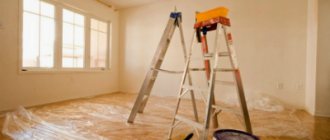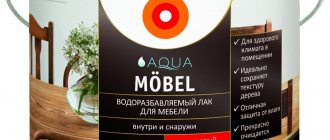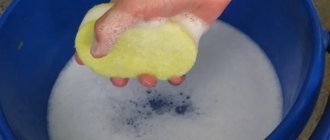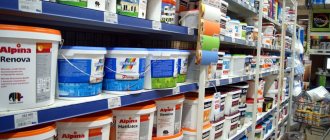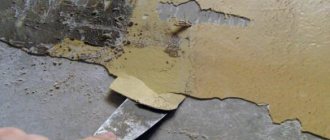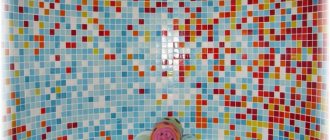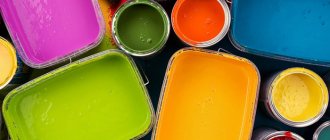Types of paints and varnishes
The composition of paints and varnishes includes binders, fillers, pigments, solvents/thinners and additives. In order to competently use paint and varnish materials during repairs, you need to know exactly their composition.
Main components
Oil paints based on drying oil.
All paints are divided according to the type of binder used and the type of solvent.
- The binder determines the main qualities of the paint, the service life of the coating and the speed of its drying
. There are 4 common types of binders used for paints and varnishes: alkyd and epoxy resins, oil-based (on drying oil), latex, acrylic polymers. - Solvent components are divided into solvents themselves and diluents
. The former reduce the fluidity and viscosity of the material. Thinners only reduce the viscosity of the paint. - To improve the characteristics of paints and varnishes, additives are added to their composition
: stabilizers, emulsifiers, fungicides, antiseptics, etc. - Special paints belong to a separate category
. These are anti-corrosion coatings, for example, Zinga electrically conductive paint. Analogs with antiseptic properties that protect the base from mold and rot. Compositions for removing small defects (irregularities, scratches, cracks), etc.
Oil and enamel compositions
The photo shows acrylic enamel.
Materials based on alkyd and acrylic resins include oil and enamel paints. They are suitable for painting metal, wood and plastered surfaces.
After drying, they are non-toxic, light and moisture resistant.
- Oil paints are produced on the basis of drying oil. White Spirit, gasoline, turpentine or solvent naphtha are used as diluents. The compositions are not expensive, but they take a long time (up to several days) to dry. The main disadvantage is that over time the coating turns yellow.
- Varnish is added to enamel compositions as a binder. It gives the coating gloss and aesthetics. The instructions recommend using such paints for external and internal finishing work on metal, wood, concrete, and plaster. Enamels are moisture and light resistant. They also have anti-corrosion resistance.
Emulsion and dispersion materials
Water-dispersed composition.
Such paints are diluted, but not soluble with water. In them, the binder and pigment particles are distributed in a liquid medium, creating a stable emulsion.
When the coating dries, it is not washed away by water.
- Emulsion compositions are economical, environmentally friendly and fire safe.
- They fit well on almost any substrate.
- They dry quickly and do not have a pungent odor.
Many people think that water-based and water-dispersion compositions are the same.
However, they are different.
- Matte emulsions wash off over time. The dispersions are waterproof and suitable for use in damp areas.
- Water-dispersion compositions are usually white; water-based analogues have a variety of colors.
- Dispersions cannot be used at temperatures below +5 degrees. However, with the addition of modifiers, they are thermally stable. Such, for example, are fire-retardant paints for metal Polistil.
- Such compositions are frost-resistant after they are completely dry.
- They are vapor permeable.
- Suitable for alkaline substrates (concrete, plaster).
- These paints are tinted very well.
- Resistant to ultraviolet radiation, retains its original color for a long time.
- They have the ability to repel water.
- They have high mechanical stability.
Differences in paints
Before you understand whether it is possible to paint products coated with acrylic with alkyd paint, you need to understand the compatibility of these enamels.
- Acrylic paint bases last longer on the surface. Alkyd enamels are not so durable. And if the product or surface is cleaned and primed before painting, the coating will remain for more than 20 years. Surfaces coated with alkyds become unusable a year after the first painting.
- Acrylic is indifferent to the effects of ultraviolet rays. Under direct sunlight, the enamel does not peel, does not turn yellow, and does not lose transparency. The Alcides cannot boast of this.
- But alkyd paints dry faster. Therefore, they are indispensable for quick coloring. Unlike competitors, which only need two days to dry completely, acrylics dry for a month.
- Acrylics take a long time to dry, but during this process a film is formed that is more resistant to mechanical damage. Other coatings do not differ in such properties.
- Alkyd substances have a wide variety of shades, which is not typical for acrylic paints. If choosing non-standard colors is important, it is better to choose acrylic enamels.
Painting rules or how not to make mistakes
When the surface is pre-prepared and well-dried, proceed to applying the desired shade of water emulsion on top. The entire procedure must be carried out carefully and slowly.
- We prepare the necessary material and equipment (brushes, paint tray, roller).
- Pour the paint into the tray and make sure that it is not too thick, otherwise it will be difficult to apply it to the surface.
- Make sure the direction of the brush is correct relative to the incident light. This will prevent the dye from leaving streaks, and the paint will in turn lie smoothly.
- Apply paint in several layers (at least three). If there was no sanding beforehand, then you should choose a thick paint consistency.
Removing old oil paint from wallsSource roomester.ru
Scraping old oil paint from wooden walls using special equipmentSource ecosystems.pro
Is it possible to apply acrylic paint over water-based paint?
This is a question faced by many who are renovating an old building. Indeed, the final result of all work may depend on the correctness of the decision.
Such painting is allowed if there is no damage, swelling or peeling on the surface, if re-painting is required when laying in several layers and if the compositions used are similar. The fact is that the acrylic version is not applied without consequences to all types of water-based compositions.
In other cases and in the absence of confidence in the final result, it is better to completely clean the coating.
Answers from experts
N:
rrr:
you can... but is it necessary?
Stepa:
On the contrary (in the sense of oil in emulsion), no. And the emulsion goes on well even without preparation (the first layer is a little worse). Well, if you sand an oil-painted wall and prime it with a good primer like “Dufa”, your paint will last happily ever after.
trickster:
maybe just a few layers. You can’t use nitro paint, it will peel off
Olga Smychenko:
You can if you use caparol matlatex or caparol malerit paint. But before that you need to prime it with Ceresit primer and let it dry for 12 hours.
Vita Marchenko:
It will be difficult to paint and then when washing the water emulsion will be downloaded
Olesya Chernova:
Anything is possible, it will be ok, that weekend we were painting the ceiling at the dacha. It turned out great, nothing was cut, just the dust was washed off the ceiling.
Svetlana Spiridonova:
No. And if you really need to, then peel off the old paint, prime it, then level the surface, sand it with fine sandpaper and only then paint. If you are leveling with a coarse putty material (Rotbant), then sand with coarse sandpaper (sandpaper). If you are leveling with a finishing putty (Vetonit LR+). That's fine sandpaper.
Maxim Prolygin:
If you take a facade emulsion, it sticks to almost anything.
Alexei:
Of course you can, go over it with fine sandpaper, then two layers of primer, and then paint it two or three times (depending on the quality of the paint) and that’s it.
Alexander Khvostantsev:
Of course it will - where will it go?
Korolev Yuri:
You just need to do the preparation and sand the paint with sandpaper, go through the primer and then paint it in several layers with water-based emulsion
Dmitriy Geshtalt:
When painting any surface, special attention should be paid to the compatibility of paint materials. Water-dispersion paints are poorly compatible with solvent-based enamels (MA, PF, NC). The use of water-dispersion paints in the interior and exterior is much more profitable and environmentally friendly than solvent-based enamels
On a façade, for example, water-dispersed paints last from 8 to 12 years, while PF enamel lasts only 3-5 years. In addition, water-based paints, unlike enamels, form a “breathable”, vapor-permeable coating
The use of water-dispersion paints in the interior and exterior is much more profitable and environmentally friendly than solvent-based enamels. On a façade, for example, water-dispersed paints last from 8 to 12 years, while PF enamel lasts only 3-5 years. In addition, water-based paints, unlike enamels, form a “breathable”, vapor-permeable coating.
Considering the above advantages of water-dispersion paints over enamels, it is not surprising that they are crowding out solvent-based products in the market of paints and varnishes. The consumer’s desire to use more environmentally friendly, cheaper and durable materials is understandable. But, unfortunately, it will not be possible to simply apply water-dispersion paint to a surface previously painted with PF enamel. The most radical method of solving the problem is to remove the old paint. With the help of “Paint Destroyer B-52” you can easily get rid of any putties and alkyd enamels without damaging the surface being cleaned.
Apply a 1-2 mm layer of “Paint Destroyer B-52”; after 30 minutes, remove the peeled paint with a spatula. If this is difficult to do, we recommend using acrylic “Special primer PARADE Reanimator G 40”, which is intended for priming various types of surfaces previously painted with alkyd or oil paints for further finishing with water-dispersed materials.
It is enough to thoroughly mix the ready-to-use PARADE Reanimator Special Primer, then apply it in one layer to the surface with a roller or brush. After 1 hour, the PARADE Reanimator Special Primer will dry, forming a translucent, slightly rough surface that is ready for painting with water-dispersed materials.
Flaws
So:
- When painting with latex enamel, the surface must be perfectly flat, since the consistency does not allow covering all defects and irregularities.
- Low temperatures have a negative impact on latex coatings. Frequent drafts and temperature changes can lead to cracking of the paint layer, and you will have to completely redo the entire job.
- Additional impregnation is required. Water-based paints are harmless not only to humans, but also to all kinds of bacteria and mold, so if the surface is not treated with a special impregnation or primer in advance, microorganisms will certainly begin to develop on latex paint.
Advice! When using a primer, it is better to choose the same brand as the paint. This can guarantee high quality coatings and no conflicts between materials.
Difference between acrylic and water-based paint
How do these materials differ from each other? A water-based composition is a large group of mixtures for which water is the solvent. The final properties of the product depend on the additives; they can be polymer or mineral.
Acrylic solution is a type of water-based emulsion. The composition of this mixture is: dye, polymer emulsion (in this case acrylic), distilled water and special additives to improve characteristics. Thus, a more modern composition with excellent qualities is obtained.
- Water-based paint is often associated with traditional paint that contains chalk or slaked lime. Basically, such mixtures are prepared independently with the addition of PVA.
- Differences in GOST. This regulatory document reflects all the technical characteristics of the material. Under number 28196-89 there is water-dispersion paint, which often has a more popular name - water-based emulsion. Such confusion arises due to the fact that the expansion of GOST occurs very slowly. The characteristics specified in 1989 no longer correspond to the range of products present on the market.
Technical characteristics of acrylic compositions
Acrylic paint has properties that distinguish it from classical materials:
- Good viscosity. The solution does not flow off the surface, which ensures uniform distribution and quick fixation.
- Light weight. This eliminates the overall load even on a fragile base, such as drywall.
- Good hiding power.
The composition is applied at temperatures above +15 and humidity 65–70%. Other specifications vary by manufacturer.
How to paint walls with water-based paint
Before starting painting work, the paint is mixed manually or with a construction mixer. The desired color is selected on a test surface by adding a certain amount of coloring pigments to the base composition.
You should not start painting the surface right away - it is recommended to paint a small area on plywood, for example, and wait for it to dry to see the final color of the painted surface - wet and dried paint will always be different in color, and this must be taken into account. The working surface is first leveled, cracks and cracks are sealed, primed and allowed to dry completely.
If paint is applied for the first time, it is recommended to use the rules for selecting colors for different rooms. For example, if the windows are located on the south side of the room, then it is better to use shades of the cold spectrum - from violet to blue. It is better to paint a room with windows facing north in warm colors - from red to orange.
Ways to solve the problem - additional tips
It follows from this that the evenness of the oil coating directly depends on the conditions and time of operation of the room. The quality of the original paint, naturally, also affects the subsequent application process. Often the wall looks like a washboard. If you paint directly on such a surface, you will get a terrible result.
How to avoid this situation? You can try the following three methods that are cost-effective for minor home renovations.
- Matting. If the oil surface is preserved in good condition, matting will allow you to remove the glossy surface (that very film), which creates problems with the penetration of the water base. Expected result: the paint should be able to adhere to the wall, as the obstructive layer will be eliminated. The matting process is primitive. The wall is washed and dried with a construction hairdryer, after which it is worth using drying oil to coat the entire surface, and a layer of water-based emulsion can be applied on top. The mechanical type of matting looks like this: the surface is rubbed using fine sandpaper. In this case, reliability is increased, the gloss will be removed with guarantee.
- Padding. Suitable for already worn surfaces. If you can cover some parts of the wall with soil, where the crumbling is most obvious, you will be able to level out the failures. Unfortunately, it is almost impossible to cover a wall with major damage with putty and level it. Modern specialized soils should be used, which are abundantly available on the building materials market. Ease of use and drying speed make it possible to use such materials even with a low degree of preparation of the working surface. The drying speed of modern primers allows painting within an hour after application. This method is beneficial for large gaps, often obtained when painting with oil paint, and will also allow the liquid of the water-based coating to be well absorbed.
- Delete. The best in terms of efficiency, but the most labor-intensive process of carrying out the procedure in question. Complete removal of oil paint down to the concrete base of the wall allows for better results when applying another paint to the surface. Let's look at how to do this process as quickly as possible. You can knock off the paint by hand, but it is better to find an opportunity to use a power tool. Both a grinder and a drill with specialized attachments will do. You can knock off the paint directly with a hammer drill. The process will take a long time to occur when using conventional mechanical tools; carry out this work only if there is a complete absence of alternatives and in conditions of a small volume of work in the room. The end result is a completely clean wall.
How to calculate consumption?
Before purchasing, it is necessary not only to decide on the type and color of the ceiling paint, but also to calculate the required volume, which is determined by its consumption. The required quantity depends on the size of the room, which determines the ceiling area. Usually, all the necessary information for calculating the color composition is on the packaging, so you should definitely read the instructions.
In general figures, you can focus on the following calculations. The average consumption of water-dispersed paint when finishing ceilings is about 100 – 120 g/m2. Depending on the surface, at least two or three coats will be necessary to achieve a good, uniform finish. The material consumption is approximately the same whether using a roller or using a brush.
If we take into account the lack of experience and the inability to rub paint professionally, then the average consumption will be 300 g/m2
Having chosen the required type of water-based paint, you can read information on the packaging about whether it requires dilution. If manufacturers recommend diluting the purchased material, then water can be added to the required amount of paint; as a rule, no more than 5-10% is required. It is best to use the prepared volume immediately; do not let it thicken again. The best option is considered to be diluting the paint to the state of liquid cream.
It happens that the material does not require dilution; it is enough to just mix it thoroughly. Such manipulations will be enough if you plan to paint the ceiling in one layer; in such situations, the paint should be a little thicker.
For the entire surface of the ceiling, you should purchase paint from the same manufacturer, the same brand. This requirement guarantees a uniform, monochromatic coating.
Water-based paint
It is a generalized concept of paint and varnish products, divided into various subtypes. Contains pigments, special-purpose polymer substances, and water. Some varieties contain acrylic and silicone resins. The consistency required for painting the surface is obtained using solvents. The exact paint consumption per square meter depends on the type of surface being painted.
Advantages
Water-based paint is absolutely safe for humans, does not emit toxic fumes into the environment, and also:
- has no odor after drying;
- has an affordable price;
- simple and easy to apply.
Painting can be done using a roller or a ball-type brush. To obtain the desired shade, coloring pigments are added to the paint. The paint and varnish material is ideal for performing interior finishing work at temperatures from 5 degrees above zero. Drying quickly, it allows you to apply a new coat almost immediately after the first.
Varieties
The following types of water-based paint are available: mineral, silicate, silicone and acrylic. Each differs in composition and scope of application. The most expensive type is silicone, which fits and holds perfectly. The most affordable is water-based mineral paint, the main component of which is either cement or slaked lime. The advantage is that it perfectly paints any surface, but does not have a long service life due to its high susceptibility to negative external factors. The specific properties of the paint and varnish coating largely depend on the composition and subtype. Acrylic, in fact, is a type of water-based one. Its cost is in the average price range, and its scope is quite wide. It is used for painting plastered, brick and wooden surfaces.
Properties and composition of water-based paint:
The main characteristics of water-based paint are its environmental friendliness and hypoallergenicity . It does not have a strong odor, does not emit toxins hazardous to humans and the environment, and does not require the use of a solvent to wash it off hands. This coating dries quickly, has good adhesive ability and vapor permeability.
Chemical composition
Water-dispersed paint is suitable for painting different types of surfaces, such as wood, concrete, plaster, drywall, wallpaper, and can also be applied to a surface previously painted with another type of paint.
Tile
Is it possible to paint old tiles?
Yes - provided that it is not glazed. No paint will adhere strongly enough to glass-like glaze.
Solutions
After cleaning from lime and other deposits, the tiles can be painted without prior priming. In this case, you will have to use wear-resistant, highly adhesive paints based on urethane or epoxy. It is acceptable to use acrylic-latex rubber paints: at a moderate cost, they, like the two types of dyes mentioned above, will provide complete waterproofing of the surface.
Two-component epoxy paint.
Technology
How to do the work of preparing and painting tiles yourself?
- To remove deposits, it is better to use acidic agents - Sillit, solutions of hydrochloric or oxalic acids. The product is applied to the surface and washed off after 10-20 minutes. If necessary, processing is repeated several times.
Oxalic acid is an effective means for removing lime deposits.
- Two-component dyes are mixed with a hardener immediately before use.
- The wall and plumbing adjacent to the tile are protected with masking tape.
- The paint is applied with a brush or roller in one or two layers.
Acrylic copolymer based product
The acrylate binder in these paints can have a varied composition and contain copolymers - additional chains that modify quality parameters. The number of available copolymers is extensive and covers most needs for materials with special properties.
The latex component improves the characteristics of acrylic, making the paint more popular, although more expensive.
Features and Specifications
Common positive properties inherent in both acrylic and latex paints include:
- strength and durability of the resulting polymer layer;
- rich colors that do not lose brightness over time;
- stability under the influence of ultraviolet radiation from the sun;
- water base, which ensures the non-toxicity of the color mixture and the absence of unpleasant odors during operation.
Latex additives modify the strength and visual properties of acrylic paints, giving them the following characteristics:
- high elasticity - latex paints can be applied over embossed walls and wallpaper, since they follow any curves of the base well;
- aesthetics - rubber additives give the surface a visual silkiness;
- resistance to abrasion and water. Most latex paints are suitable for intensive washing, which cannot be said about ordinary acrylate compositions.
Product types
There is no strict classification of mixtures with rubber additives, although manufacturers usually indicate their properties and purpose in the information on the packaging. The most common types of paints are:
- matte, semi-matte and glossy - used for various purposes and surfaces. The glossy mixture is applied only to perfectly smooth walls or ceilings, since even minor irregularities and defects will become clearly visible under the gloss. Matte paint is better suited for less level walls and floors, while semi-matte acrylic copolymer latex paint has intermediate properties;
- facade, for walls, ceilings or floors - determine the main purpose of the paint. Although a significant part of the compositions are universal and can be used for identical purposes, it is better to follow the manufacturer's advice and apply the paint to suitable surfaces. And yet, the question often arises as to whether acrylic or silicone facade paint is better;
- washable, impact-resistant and moisture-resistant - characterize the main parameters of the coating after evaporation of the thinner (water). The properties of latex acrylic paints are similar to each other, so even mid-price compositions will provide high quality painted layers.
Material cost
The minimum price for acrylic latex paint is approximately 200 rubles/l. The cheapest products are from little-known companies. Sometimes ordinary acrylic dispersion is sold under the guise of latex paint, and the word “latex” appears only in the inscription on the label.
In order not to make a mistake with your choice, you should purchase products from more well-known manufacturers. The highest quality compositions can cost up to 1000 rubles/l or more, fully performing the functions assigned to rubber decorative coatings.
Below you will find a useful video on how to treat walls using acrylic latex paint Snezhka, and also learn about the advantages of this type of material:
Next we will talk about whether acrylic and latex paints can be mixed.
The difference between latex and acrylic
First, it’s a good idea to find out how acrylic and latex paints differ, how compatible they are and how they can be mixed.
Latex in an aqueous solution contains rubber colloidal particles (synthetic) and emulsifiers. There are latex paints with natural latex - these are juices:
- poppy,
- Hevea,
- Dandelion.
They cost more, the differences are visible only to a specialist. Rubber particles based on the following bases act as artificial latex:
- Uretanova,
- Siloxanova,
- styrene butadiene,
- Isoprene,
- Acrylate.
Acrylic paint consists of acrylate copolymers and rubber filler, in most cases, styrene-butadiene group. As you can see, latex and acrylic are two boots of a pair - compositions on the same basis.
If you see the name “Acrylic paint with latex”, then don’t rack your brain, they just added butadiene styrene to the acrylic composition. This is done for one purpose - this reduces the cost of coating, since pure acrylic is expensive.
Types of paints and varnishes
The composition of paints and varnishes includes binders, fillers, pigments, solvents/thinners and additives. In order to competently use paint and varnish materials during repairs, you need to know exactly their composition.
Main components
Oil paints based on drying oil.
All paints are divided according to the type of binder used and the type of solvent.
- The binder determines the main qualities of the paint, the service life of the coating and the speed of its drying. There are 4 common types of binders used for paints and varnishes: alkyd and epoxy resins, oil-based (on drying oil), latex, acrylic polymers.
- Solvent components are divided into solvents themselves and diluents. The former reduce the fluidity and viscosity of the material. Thinners only reduce the viscosity of the paint.
- To improve the characteristics of paints and varnishes, additives are added to their composition: stabilizers, emulsifiers, fungicides, antiseptics, etc.
- Special paints belong to a separate category. These are anti-corrosion coatings, for example, Zinga electrically conductive paint. Analogs with antiseptic properties that protect the base from mold and rot. Compositions for removing small defects (irregularities, scratches, cracks), etc.
Oil and enamel compositions
The photo shows acrylic enamel.
Materials based on alkyd and acrylic resins include oil and enamel paints. They are suitable for painting metal, wood and plastered surfaces.
After drying, they are non-toxic, light and moisture resistant.
- Oil paints are produced on the basis of drying oil. White Spirit, gasoline, turpentine or solvent naphtha are used as diluents. The compositions are not expensive, but they take a long time (up to several days) to dry. The main disadvantage is that the coating turns yellow over time.
- Varnish is added to enamel compositions as a binder. It gives the coating gloss and aesthetics. The instructions recommend using such paints for external and internal finishing work on metal, wood, concrete, and plaster. Enamels are moisture and light resistant. They also have anti-corrosion resistance.
Emulsion and dispersion materials
Such paints are diluted, but not soluble with water. In them, the binder and pigment particles are distributed in a liquid medium, creating a stable emulsion.
When the coating dries, it is not washed away by water.
- Emulsion compositions are economical, environmentally friendly and fire safe.
- They fit well on almost any substrate.
- They dry quickly and do not have a pungent odor.
Many people think that water-based and water-dispersion compositions are the same.
However, they are different.
- Matte emulsions wash off over time. The dispersions are waterproof and suitable for use in damp areas.
- Water-dispersion compositions are usually white; water-based analogues have a variety of colors.
- Dispersions cannot be used at temperatures below +5 degrees. However, with the addition of modifiers, they are thermally stable. Such, for example, are fire-retardant paints for metal Polistil.
Note! The best analogues of water-based paints are based on acrylic resins and polymers. They have high elasticity and strength
- Such compositions are frost-resistant after they are completely dry.
- They are vapor permeable.
- Suitable for alkaline substrates (concrete, plaster).
- These paints are tinted very well.
- Resistant to ultraviolet radiation, retains its original color for a long time.
- They have the ability to repel water.
- They have high mechanical stability.
Representatives on the paint market
There are many options for latex products from Russian and foreign brands on the market.
They differ in scope of use, characteristics and cost. When choosing a coating, you should proceed from the characteristics of the base, the functions of the coating and the budget.
Olimp
One of the most famous domestic manufacturers, offering coatings for various operating conditions. The manufacturer's products include paint options with high wear resistance. There are also paints and varnishes for walls, ceilings and wallpaper.
Tikkurila
The Finnish manufacturer offers a lot of options for latex coloring materials. Tikkurila's line includes compositions for painting floors, facades, and walls in public spaces. Among the manufacturer's products there are paintwork materials with increased moisture resistance. The compositions are environmentally friendly and economical. The manufacturer indicates the consumption of latex paint per 1 m² is 125 ml. They are characterized by a high setting speed.
Dulux
The brand from the English manufacturer Azco Nobel offers a smaller variety of latex products. At the same time, the line includes compositions for interior and exterior use with a high level of moisture resistance and vapor permeability. Matte options are offered for painting indoor walls.
Parade Diy
Paint from the manufacturer Parade closes our current rating of the best. The product is in great demand due to its excellent covering ability, economy and frost resistance. The composition is white, however, it can be tinted in different colors.
| Consumption | 11 m²/l |
| Tinting | PARADE |
| Packaging (l) | 9 |
| Drying time (hours) | 24 |
Price: from 2310 to 2550 rub.
latex paint Parade Diy
- moisture- and frost-resistant;
- creates a durable surface coating;
- environmentally friendly paint;
- convenient tinting system (814 shades in the catalogue);
- recommended for use in children's and medical institutions.
- stains appear when in contact with greasy substances.
I have been painting walls for about 2 years. All this time I only take Parade paint - it is easy to apply, has an excellent appearance when applied and there are many shades of colors in the catalogue.
Tex Profi Superwhite
The following paint is used for finishing walls and ceilings. It is in great demand among buyers: paint is purchased not only for domestic purposes, but also during the arrangement of commercial buildings, hospitals and industrial warehouses. Excellent characteristics and level of coverage for the money!
| Consumption | 9-11 m²/l |
| Color. | “Profi” TEX |
| Package (l) | 9 |
| drying t (hours) | 24 |
Cost: from 1529 to 1679 rubles.
latex paint Tex Profi Superwhite
- without smell;
- convenient to apply;
- walls can be washed;
- low material consumption (9-11 m²/l);
- high quality paint;
- easy to lay on surfaces;
- long shelf life (2-4 years).
- not detected.
I work as an interior designer, so I need quality paint quite often. Tex Pro Super White is my find. For 9 liters I pay about one and a half thousand rubles, it lasts a long time and is used sparingly. And you must agree, the price is quite inexpensive for truly excellent quality! By the way, the preparation of the surface for painting is usually minimal, however, it fits perfectly on it.
VITEX SATIN ECO
The best paint among the Vitex product line: composition, covering ability and wear resistance are excellent. There are no harmful impurities in the composition, the paint is odorless and dries quickly, and it perfectly emphasizes the texture of the wallpaper. This option will suit everyone who is planning a renovation.
| Consumption | 11-14 m²/l |
| Color. | Colorfull |
| Package (l) | 10 |
| drying t (hours) | 24 |
Cost: from 2800 to 3500 rub.
latex paint VITEX SATIN ECO
- has no smell;
- in the catalog of pigments there are 833 colors to choose from;
- waterproof;
- Contains antibacterial components against mold.
- highlights defects on uneven surfaces.
We bought Vitex paint in the summer on the advice of the seller. At first we wanted to take a cheaper option, but decided not to skimp on quality. Repairs are not done very often, so the materials must be of the highest quality. In the end, we did not regret the purchase: the paint applied smoothly, had no odor, and the coating can always be washed. In general, some advantages.
NEWTONE SKY (9 L.)
Are you planning to paint your ceiling ultra white? Then pay attention to this paint. It is specially designed for decorating ceilings in rooms with normal humidity levels. If you want to achieve a different color, then use a suitable color by adding it to a white base.
| Material consumption | 160-180 g/m² |
| Color. | ColorMix |
| Packaging (l) | 9 |
| Drying time (hours) | 24 |
Price: from 889 to 1110 rub.
latex paint NEWTONE SKY (9 L.)
- environmental friendliness of the composition;
- suitable for most surfaces;
- Sold in almost any hardware store.
- high material consumption (160-180 g/m²);
- poor hiding power.
I work as a consultant in a hardware store. I often hear positive reviews about this paint; it is popular among buyers. After purchasing my own apartment, I also decided to use it - the result is very good, I am satisfied with both the price and the quality of the material. In addition, the paint has a completely neutral smell, which is good news.
What is the difficulty of applying
The basis of the water-based emulsion is water, in order to obtain reliable fixation, the surface is impregnated with the water base, and after drying it evaporates. However, the oil base does not allow water to penetrate into the wall; the drying process of the water-based coating involves evaporation of moisture; on such a coating it will not occur evenly, and accordingly the paint on top will come off. In those areas where the layer of oil composition has come off, adhesion will be good, in the rest it will be low.
There are three ways to solve the problem:
- From a well-adhering coating, the film layer is removed, which makes impregnation difficult. First, the entire surface is washed with detergents, then they are washed off with clean water. Next, drying oil is applied to the dry wall; it will create an intermediate layer between the paints;
- For a wall or ceiling with small cracks, use putty to eliminate them, or apply a primer mixture;
- The best option remains to remove the old finish completely. It is carried out using a hammer drill or grinder. The equipment is used to remove the previous coating, the process takes a lot of time and requires a lot of effort. Or they use specialized washing solutions; they soften the composition, after which the finish can be removed with a spatula. They cannot cope in all cases, so they switch to a mechanical method.
The best option remains to remove the old finish completely.
Choosing between glossy and matte paints
On a cleaned surface, latex-based paint gives the following effect:
- glossy
- matte
- semi-gloss
- semi-matte
- completely matte
- absolutely glossy
When performing interior work, the gloss parameter must be taken into account, since different textures have different characteristics and change the perception of the room.
Semi-matte and semi-gloss materials are optimal for finishing walls and ceilings.
Thus, glossy surfaces visually expand the space and are less susceptible to dirt and dust settling. However, gloss requires perfectly smooth surfaces; it does not hide defects and loses its attractive appearance with frequent washing.
Matte paint, on the contrary, hides unevenness well and is easy to clean, but dirt and dust accumulate on it more quickly. In addition, visually, a space where the walls or ceiling are matte looks smaller and darker.




